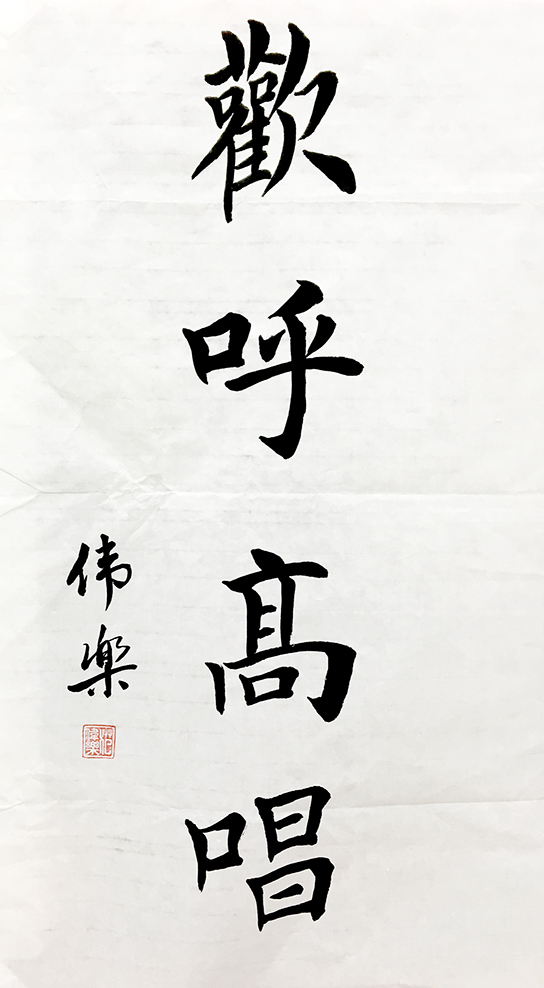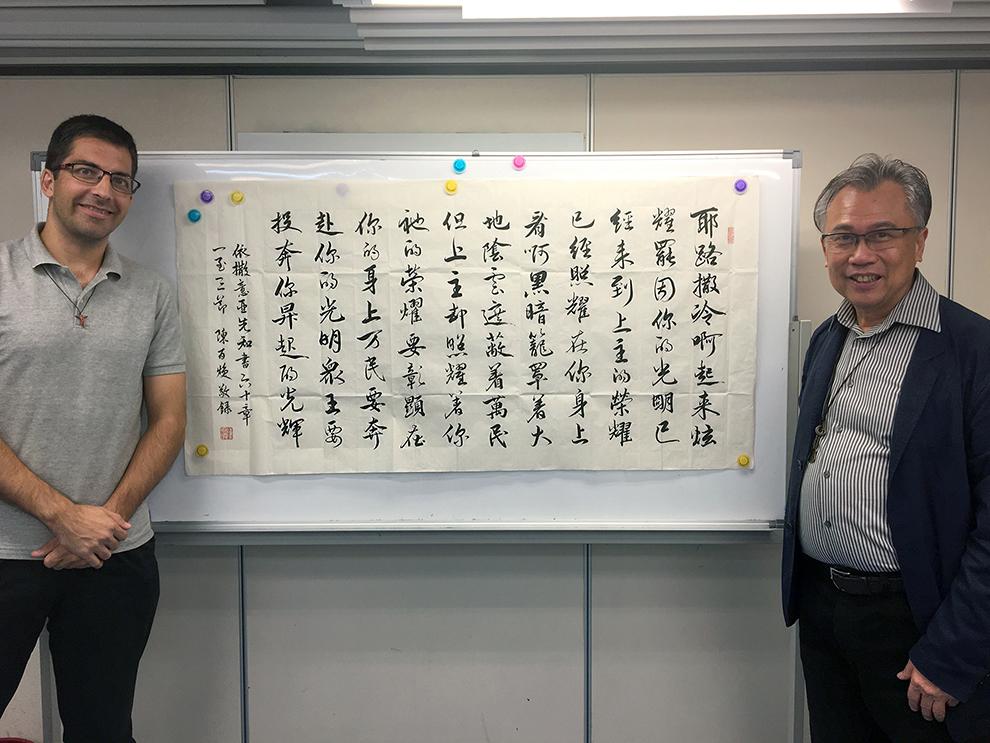- 歡呼歌唱 – Acclamez et chantez.
- Avec mon premier professeur à Canton.
- Calligraphie du caractere du bonheur 福 pour le Nouvel An.
For each young MEP missionary, the first three years are the occasion to focus all one’s heart and energy towards the learning of the language and culture of one’s mission country. After roughly two years spent in the universities of Hong Kong learning Cantonese, I had the joy of continuing this learning by spending a semester in a big town in the south of China. Through the intermediary of a Chinese friend, I contacted a calligrapher grandmother who, upon my request, accepted to teach me the fundamentals: how to hold the brush, the maintenance, the concentration, the breathing, a peaceful frame of mind. I owe my first teacher a lot! I met her regularly at her apartment to show her my work, receiving criticisms and encouragements.
Little by little, I developed a taste for it and realized that it was an excellent way to enter more deeply into the Chinese culture and the hearts of the Chinese people.
Upon my return to Hong Kong, I was appointed vicar in the Holy Redeemer parish and I quickly found a weekly night class for calligraphy in the neighborhood’s cultural center. It was a surprise for the teacher and the other students to have a Chinese-speaking occidental. Very quickly, I became part of the group.
Every week, we are asked to bring our “homework”. At the beginning of the lesson, the calligraphies are placed side by side and the teacher makes comments on them one by one, giving encouragements and advice to improve so or so area. In the second part of the lesson, the teacher presents the calligraphy to be made for the next week by doing the calligraphy himself in front of us. Through little strokes, he initiates us to various master calligraphers, to different techniques and ways to describe such and such characters, as well as the importance of balance, breath, and the pressure to exert by the brush on the paper to give life to the calligraphy. A beautiful calligraphy must have force, vigor and breath!
Little by little, we studied the different styles of calligraphy corresponding to the evolution of handwriting throughout Chinese history. (Zhuanshu), (Lishu), (Caoshu), (Hangshu), (Kaishu). Fascinating. For my part, I prefer the (Hangshu) which, while remaining decipherable, allows for a freedom of artistic expression.
How to write?
The Chinese writing is composed of thousands of characters and each corresponds to a sound and a word. There are over 50,000 Chinese characters, but 4,000 to 5,000 characters are enough for the current language.
The writing of these characters must follow strict rules to be legible and balanced. Each character must remain in an imaginary square and the strokes must be made in a certain way and in a precise order, all the while respecting a certain balance with respect to the center of gravity. In general, one makes the strokes in this order: first, from the top, then in the middle, then to the left, to the right, and finally, from the bottom. One finds the eight main types of strokes in the yong character, which means “eternity”, and that the calligraphy students are required to know.
To write, the calligrapher must have the Four treasures of the Learned Cabinet. These are the brush, the paper, the ink, and the ink stone. All this is not to be taken lightly and it requires a little experience to spot the good qualities of brush and ink. The ink presents itself in the form of a small stick that one rubs on an ink stone with water to obtain a liquid ink. Now, one can find the ink in bottles, but this does not allow one to obtain all the desired densities.
“He’s the one who knows calligraphy!”
The characters are part of everyday life, we see them everywhere, written in diverse manners, either in the standard easy-to-read manner, or in a free calligraphy manner, more difficult to decipher, but much more beautiful and artistic. Each Chinese spends many years to learn and memorize them. However, with the invention of keyboards and the possibility to type characters from the romanization of characters, the pinyin, many Chinese no longer know how to write well. Many never had the occasion to learn calligraphy with ink and brush. Therefore, I have noticed that even with a beginner’s level, the ability to calligraph immediately gives me a certain legitimacy. “He’s the one who knows calligraphy!” have I heard from people presenting me to others, and wishing to put me in a good light, although I have only just begun!
It was not my initial goal but knowing that a foreigner knows how to write the characters, and takes calligraphy lessons, touches many people and it has been an occasion for new encounters. In addition to the poems and Chinese expressions in four characters, it is not forbidden to calligraph verses of the Gospel or the Bible and offer them as gifts! Besides, my teacher kindly accepted to calligraph the first three verses of chapter 60 of Isiah which are read for the feast of the Epiphany : “Arise, Jerusalem, shine! Your light has come, and the glory of the Lord rises upon you…” A very beautiful calligraphy which now decorates the entry to the MEP house of Hong Kong.
To celebrate the Chinese New Year, this teacher invited me to an evening gala with over two hundred students. In front of everyone, he presented me as a Catholic priest and good student! A good occasion to leave the Catholic circles and meet another crowd to show that faith and the Chinese culture are compatible!
P. Nicolas de Francqueville, MEP



